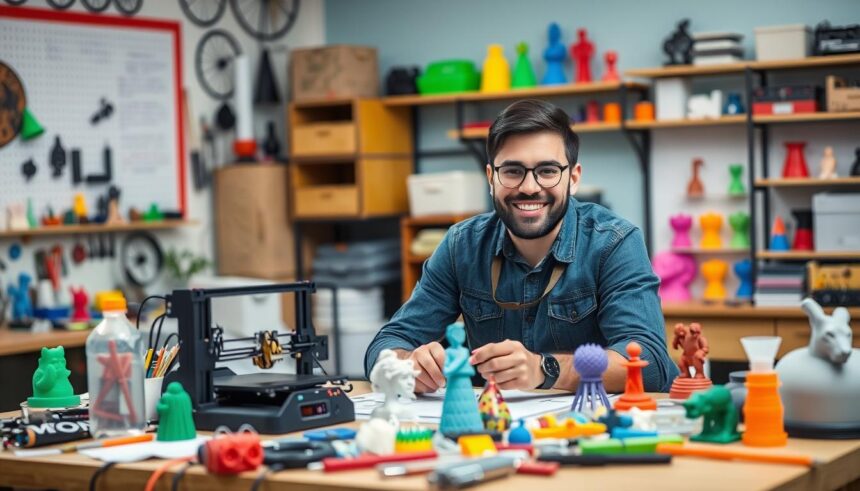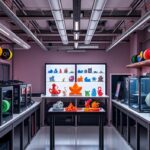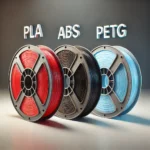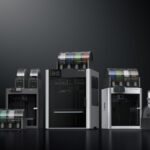Já pensou como coisas complexas são feitas do zero, camada por camada? A impressora 3d mudou muito mais que a fabricação mundial. Ela também transformou o mundo do faça-você-mesmo (DIY 3D printing). Agora, com a impressão 3d mais acessível, ela começou uma nova era de criação de objetos tridimensionais. Este guia é para quem está começando no mundo 3D. Vamos explorar as 3D Printers for Beginners, o que podem fazer e como passaram de novidade industrial para serem importantes para empreendedores, designers, educadores e fãs do DIY.
Vamos explicar como as impressoras 3D funcionam maravilhosamente, permitindo criar com precisão e detalhes antes impossíveis para a maioria. Com elas, a inovação está ao alcance de todos. Isso vale para prototipagem profissional ou projetos pessoais e educativos. Entramos em uma nova era de fabricação e criatividade, tudo graças à impressão 3D.
Key Takeaways
- Entender o básico de como uma impressora 3d funciona e sua aplicação no mundo real.
- Descobrir a acessibilidade de impressão 3d para iniciantes e como ela está moldando o futuro da produção.
- Explorar a variedade de objetos que podem ser criados, estabelecendo as bases para creating 3D objects.
- Insights sobre o impacto das impressoras 3D na inovação, tanto para uso doméstico quanto profissional.
- Introdução aos primeiros passos para começar com DIY 3D printing.
Fundamental Concepts of 3D Printing
3D printing is a key tech in digital creation. It changes how we make things from start to finish. By building objects layer by layer from a digital plan, 3D printing goes beyond old ways of making things.
Definition of 3D Printing
Also called additive manufacturing, 3D printing turns computer models into real objects. It builds these objects layer by layer. Each layer is thin and follows the shape given by 3D modeling software.
A Brief History of 3D Printing
The start of 3D printing was in the 1980s with a method called estereolitografia. This method made solid parts from liquid under UV light, one layer at a time. It was the start of adding layers to make objects, a big change in making things. Soon, new ways of printing came about, making this tech even more useful across different fields.
Principles of Additive Manufacturing
Additive manufacturing, or 3D printing, doesn’t take material away. Instead, it adds it layer by layer. This way, we can make complex shapes that would be hard with old methods. As a main part of digital making, it uses different processes for different materials and results. Here’s a look at how these processes differ, showing the versatility of 3D printing:
| Process | Material Used | Common Applications |
|---|---|---|
| Stereolithography (SLA) | Photopolymer Resin | Prototypes, Models, Jewelry |
| Fused Deposition Modeling (FDM) | Thermoplastic Filaments | Functional parts, Prototyping |
| Selective Laser Sintering (SLS) | Polymer Powder | Complex Tooling, Functional Components |
Types of 3D Printers and Their Processes
This section takes a look at the different kinds of 3D printing. It covers the main technologies like FDM, SLA, SLS, and DLP. Each one works differently and uses certain materials. This makes them suitable for various applications, from home use to industrial purposes.
FDM 3D Printing: Operation and Materials
Fused Deposition Modeling (FDM) is notable for being affordable and flexible. It involves melting a plastic filament and shaping it layer by layer to create an object. FDM uses materials such as ABS, PLA, and PETG. These features make it popular for both amateurs and professionals.
SLA and DLP 3D Printing: Understanding the Differences
Stereolithography (SLA) and Digital Light Processing (DLP) both use resin and light to print. SLA employs a laser for its precision in crafting complex items. DLP, on the other hand, uses a light projector to work on whole layers at once, which makes it faster. These methods are ideal for work requiring high detail, like in dentistry and jewelry.
SLS 3D Printing: Advantages and Challenges
Selective Laser Sintering (SLS) is prized in industrial settings for its ability to make intricate and strong objects without supports. It sinters powdered nylon with a laser to create hardy parts. However, SLS machines are expensive to run and need a special environment for the powder.
| Technology | Material Used | Primary Use | Suitability |
|---|---|---|---|
| FDM | PLA, ABS, PETG | Prototyping, educational models | Domestic and educational settings |
| SLA/DLP | Resin | High-detail models, art, jewelry | Professional and artistic projects |
| SLS | Nylon | Functional parts, complex assemblies | Industrial applications |
Materials Used in 3D Printers
3D printing offers a wide range of materials, from simple plastics to complex composites. Knowing how each material works and its best uses can greatly enhance the print quality. This understanding impacts the function of the final product.
PLA, ABS, PETG: Characteristics and Usage
PLA is loved for being easy to use and eco-friendly. It’s perfect for newbies. Made from things like corn starch, it prints at low temperatures and hardly warps. This makes it great for easy home projects.
ABS is known for being strong and long-lasting. It can handle heat and is flexible, important for tough items like car parts or toys. But, it releases fumes when printed, so you need good air flow.
PETG melds PLA’s ease with ABS’s toughness. It stands up to heat and impacts well. This makes it perfect for functional parts that need to look shiny and not break easily.
Exploring Advanced Materials: Nylon, Wood, and Metal
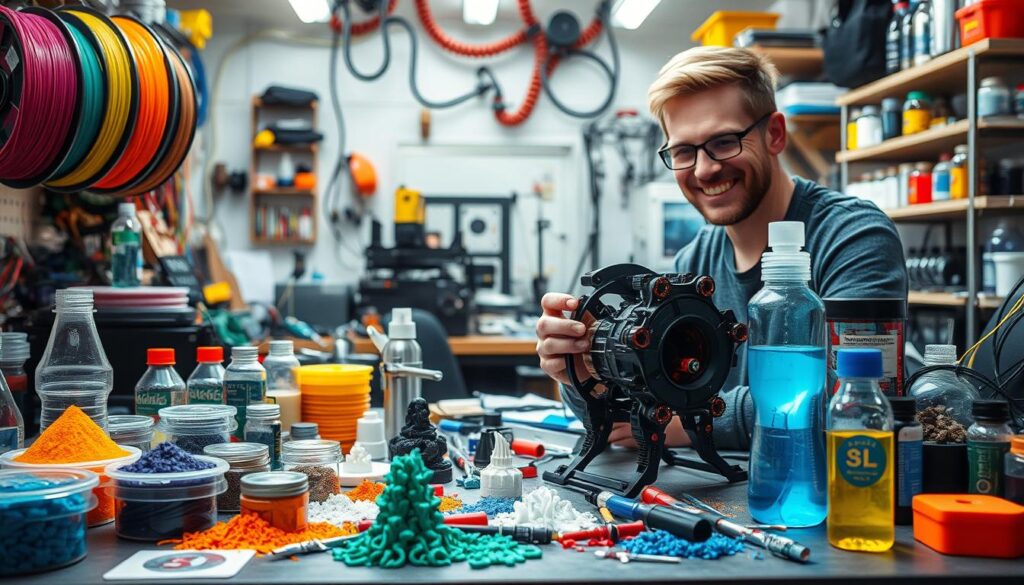
Nylon, wood, and metal open up new possibilities in 3D printing. Nylon is flexible and strong, great for durable, bendy parts like gears. It’s ideal for parts that need to last and move.
Wood-infused materials bring the beauty of wood to 3D prints. They’re perfect for decorative pieces that need a wood look. Metal blends mix PLA and metal powder, combining metal’s appearance with plastic’s ease of printing.
Here is a side-by-side comparison of these materials:
| Material | Temperature Resistance | Flexibility | Recommended Uses |
|---|---|---|---|
| PLA | Low | Low | Decorative objects, low-heat applications |
| ABS | High | Medium | Functional parts, outdoor use |
| PETG | High | High | Medical braces, food containers |
| Nylon | High | High | Tools, mechanical parts |
| Wood | Low | Low | Artistic projects, home decor |
| Metal | Medium | Low | Jewelry, statues, prototypes |
Each material has unique qualities and limitations. The choice of material is as vital as the object’s design. Whether for beautiful home accessories or practical engineering components, knowing these materials ensures great results.
3D Printers for Beginners: Getting Started with 3D Printing
Starting with 3D printing is an exciting step into digital creation. When you begin, you’ll need to pick the right software, learn important settings, and figure out how to solve common problems.
Choosing 3D Modeling Software for Beginners
Choosing the right software is crucial for new 3D designers. Platforms like Tinkercad, Fusion 360, and Blender cater to different skill levels. Tinkercad is great for beginners with its easy-to-use interface. Fusion 360 offers more advanced tools for bigger projects. Blender allows for creativity in modeling and animation.
Preparing Your First 3D Print
Before printing, you need to calibrate and level your printer. A leveled bed and calibrated extruder mean better prints. Adjusting your printing temperature and print speed is also key. Use higher temperatures for materials with high melting points. And adjust the speed based on your print’s complexity.
Troubleshooting Common 3D Printing Issues
Warping, stringing, and under-extrusion can affect your prints. Warping causes corners to lift, which can be fixed by adjusting the bed temperature. Stringing requires tweaking the retraction settings. For under-extrusion, check for a clogged extruder or inconsistent filament diameter.
| Issue | Cause | Solution |
|---|---|---|
| Warping | Uneven cooling, poor bed adhesion | Adjust bed temp, use adhesives |
| Stringing | Improper retraction settings | Optimize retraction distance and speed |
| Under-extrusion | Clogged extruder, inconsistent filament diameter | Clean extruder, verify filament quality |
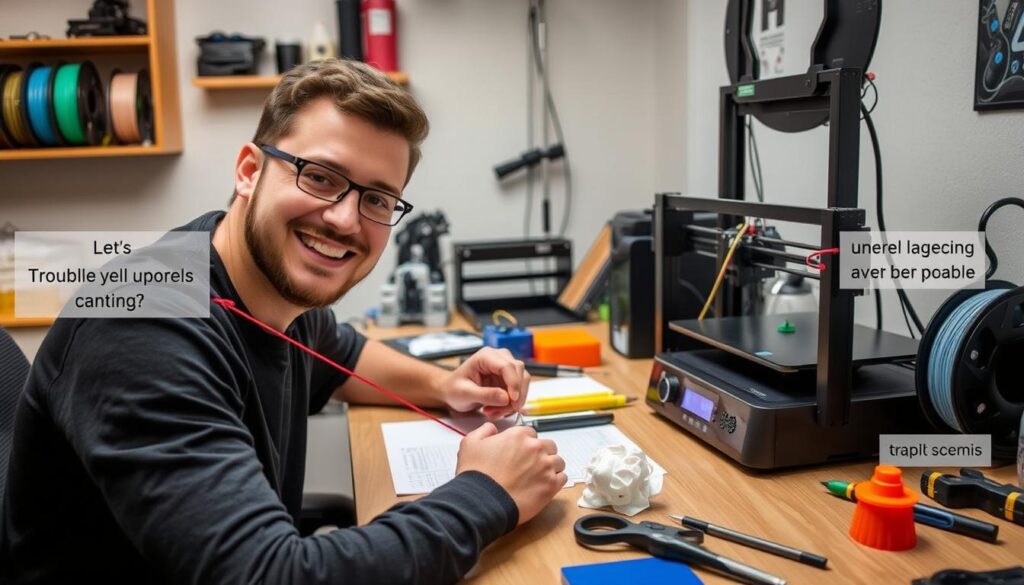
Conclusion
The world of 3D printing goes way beyond just a cool new thing. It’s a strong force for creativity in 3D design and innovation in making things. It also has practical uses in many areas like architecture, engineering, medicine, and education. With 3D printers becoming more accessible for home use, people can now bring their creative ideas to life. Also, 3D printers in schools are creating a new group of young creators and problem-solvers. These kids are ready to make big changes in their areas of interest.
Entrepreneurs and big companies alike are finding new ways to use 3D printing. It helps them make 3D prototypes quickly, saving time and money. In engineering, this technology allows for making complex models with high accuracy. This opens the door to new kinds of innovation in making things. In health care, 3D printing is changing the game by making custom prosthetics and medical models. This shows just how flexible and powerful 3D technology can be.
Getting the basics down, from knowing the different 3D printers to choosing the right materials, is key for anyone getting into this area. Beginners might find it tough at first but must keep going. They need to get better at it because the promise of 3D printing is huge. It’s set to change how we create and build things in our world. It’s pushing people and industries to see its value in creating new things, improving efficiency, and having a lasting effect on digital making and design.
FAQ
What is a 3D printer and how does it work?
A 3D printer makes objects by adding material layer by layer. It’s used in homes, schools, and businesses to create things like models, art, and parts. The printer adds layers until the object is complete.
Can you explain the fundamental concepts of 3D printing?
3D printing, or additive manufacturing, builds objects layer by layer. This is different from traditional ways that remove material to make an item. It involves designing in 3D and then bringing those designs to life.
What are the different types of 3D printing processes?
Key 3D printing methods are FDM, SLA, DLP, and SLS. Each one has its own way of making layers and uses different materials. They’re chosen based on what the printed item will be used for.
What materials can be used with 3D printers?
3D printers can use materials like PLA, ABS, and PETG filaments, especially in FDM printing. For more specialized printing, materials like nylon, wood composites, metal, and ceramics are available. This allows for a broad range of uses.
How do I choose the right 3D modeling software as a beginner?
If you’re new, start with programs like Tinkercad, Fusion 360, or Blender. They’re easy to use and have lots of learning resources. They’ll help you make your first 3D designs easily.
What are some common 3D printing issues and how can I resolve them?
Issues like warping, stringing, and under-extrusion happen often. Solving these usually means adjusting settings like temperature and speed. Also, make sure your printer is set up correctly. For more help, look for advice online.


